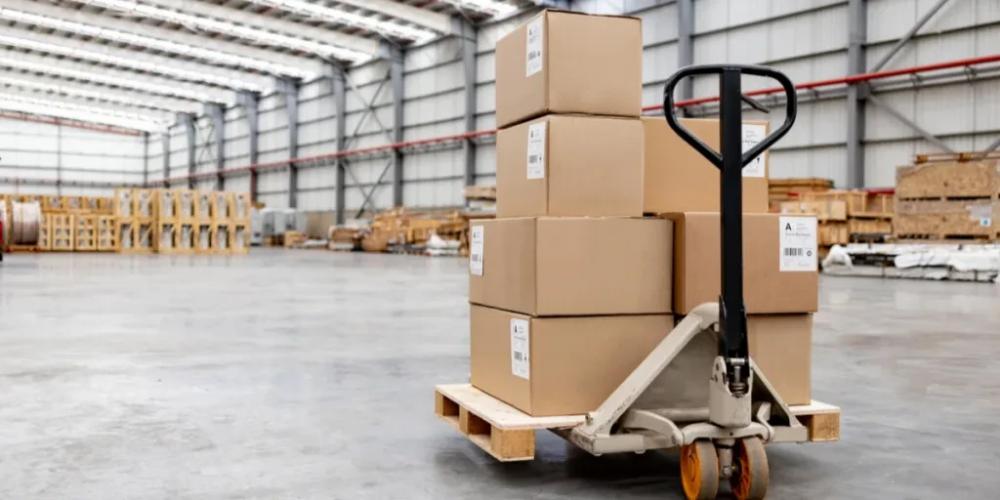How to Select the Best Pallet Trucks in 2025
71
Moving heavy loads around a worksite can be backbreaking (and sometimes dangerous) if you rely on nothing but muscle power. That’s why pallet trucks (or pallet jacks) have become workplace staples across warehouses, stockrooms, and loading bays. Not only do they reduce the strain on employees, but they also make short-distance load transport more efficient.

Whether you run a small retail backroom or a sprawling manufacturing facility, a pallet truck can simplify your daily operations. This article will go over pallet trucks in detail, including their main uses, the different types available, and important features to consider to ensure one selects the best options on the market in 2025.
What is a pallet truck?
A pallet truck is a trolley built to lift and move palletized loads. It typically features:
- Two tapered forks: These slide underneath a wooden pallet.
- Pump handle or electric lift mechanism: Workers either pump a handle manually or activate an electric motor to raise the load off the ground.
- Wheels: These allow you to steer and transport the load easily.
Because they handle heavy lifting, pallet trucks help eliminate many injuries and musculoskeletal strains from repeatedly bending down to pick up loads or wrestling awkwardly with large boxes.
3 best uses of pallet trucks
- Ideal for short-distance haulage within a warehouse or store.
- Perfect for offloading delivery vehicles or staging goods in a production line.
- Great for rearranging inventory in tight or narrow aisles.
The main types of pallet trucks
Pallet trucks come in many varieties, each suited to different tasks. Here are some of the most common types:
1. Manual hand pallet trucks
These have simple operations: Slide the forks under the pallet, pump the load, and raise it with the handle. Manual hand pallet trucks have a low upfront cost, making them great for smaller businesses. They also don’t need a license to operate.
Best for: Short distances in smaller warehouses, shops, or stockrooms where you don’t move extremely heavy loads all day.
2. Pedestrian electric pallet trucks
Electric motors help drive (and often lift) the truck for this type, reducing the operator’s physical effort. Since they significantly reduce manual labor, many businesses are rushing to adopt them, making them a popular, fast-growing category (with many styles available).
Best for: Medium-to-high volume operations where you move loads frequently but mostly over short to moderate distances.
3. Electric ride-on pallet trucks
This type looks (and works) a lot like forklifts. The operator rides on a platform (or, in some models, sits themselves) as the truck moves and lifts electrically. They are great for covering longer distances in large facilities and help reduce operator fatigue while increasing speed.
These trucks are best for big warehouses, large retail distribution centers, or any environment where employees must transport heavy pallets over longer pathways. However, they usually require operator training or a license.
4. Rough/all-terrain pallet trucks
These models have rugged wheels and sturdier frames to handle uneven ground, gravel, or outdoor conditions. They aim to save time and strain in outdoor work or construction sites. Their durable design can also withstand bumps and dips.
Best for: Farms, garden centers, construction sites, or any place you don’t always have a smooth, flat surface.
Top features to consider before you buy
If you’re in the market for one or several pallet trucks, it’s easy to focus on basic specs like price or load capacity. But a truly strategic purchase goes beyond that. Here are the top features to keep in mind:
1. Load capacity
Every pallet truck has a specified weight capacity. Exceeding that capacity is unsafe and can damage the truck’s pump and wheels, making it harder to control and maneuver. Stick to the weight limit to keep operations smooth and equipment in good shape.
What to look for: Check your heaviest regular load. Add a small safety margin to ensure your truck can comfortably handle it.
2. Fork dimensions
The length and width of the forks must match your pallets (or other load carriers). So, you must measure the typical pallet size you handle. Also, confirm if you need extra-wide forks for non-standard pallets to prevent situations where your chosen trucks can’t lift your load.
3. Operating environment
Indoor environments with smooth floors are very different from rough, outdoor terrain. A standard electric or manual pallet truck should suffice if you mostly work indoors. However, for construction sites or farms, consider rough-terrain models.
4. Power source and battery charging (for electric models)
Charging times and battery technology (lithium-ion vs. lead-acid) can affect daily operations. So, look at the model’s charging Cycles. Some batteries can charge in as little as two hours, while others need eight. Also, check the maintenance requirements, too. Lithium-ion batteries often cost more upfront but are lower maintenance and last longer.
5. Frequency and distance of use
A manual truck could be enough for short trips around a small warehouse. However, if users plan on having constant back-and-forth across a sprawling facility, they’ll want an electric ride-on to save time and operator energy.
Note: Remember to weigh the potential gains in efficiency against the higher cost of powered trucks.
6. Ergonomics and operator comfort
Tired or uncomfortable employees are more prone to errors and accidents. Focusing on ergonomics and operator comfort can help prevent such situations. Look for features like anti-vibration platforms, cushioned seats, and intuitive controls to reduce fatigue and increase safety.

Expanded Imagination: The Latest Print & Pattern Trend for A/W 2025

European Commission Nod to €9.7b Italian Renewable Energy Scheme


